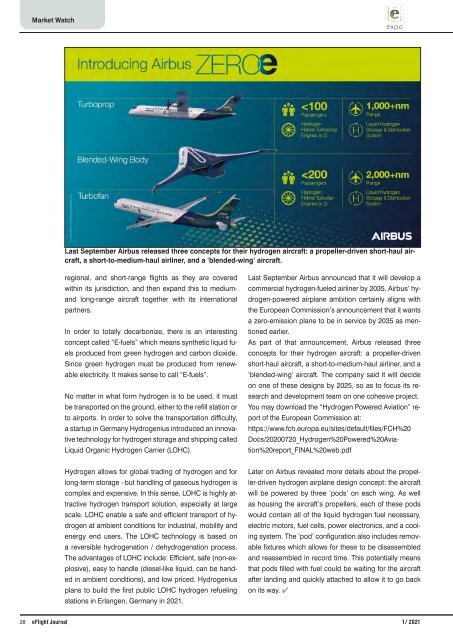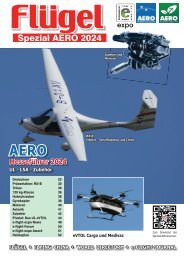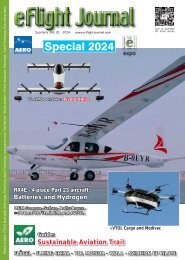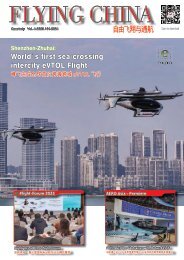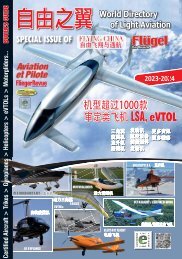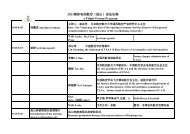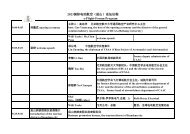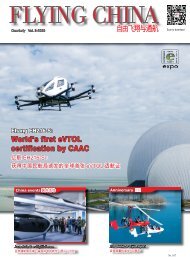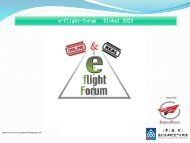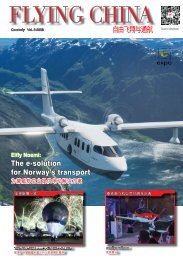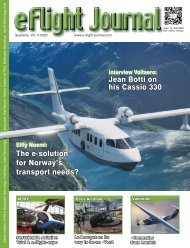eFlightJournal-04-2020+01-2021double issue
E-Flight Journal double issue The Journal for electric aviation, hybrid electrical Aircraft and Evtol from the Publisher Flying Pages
E-Flight Journal double issue
The Journal for electric aviation, hybrid electrical Aircraft and Evtol from the Publisher Flying Pages
Create successful ePaper yourself
Turn your PDF publications into a flip-book with our unique Google optimized e-Paper software.
Cover Market Story Watch<br />
Last September Airbus released three concepts for their hydrogen aircraft: a propeller-driven short-haul aircraft,<br />
a short-to-medium-haul airliner, and a ‘blended-wing’ aircraft.<br />
regional, and short-range flights as they are covered<br />
within its jurisdiction, and then expand this to mediumand<br />
long-range aircraft together with its international<br />
partners.<br />
In order to totally decarbonize, there is an interesting<br />
concept called “E-fuels” which means synthetic liquid fuels<br />
produced from green hydrogen and carbon dioxide.<br />
Since green hydrogen must be produced from renewable<br />
electricity. It makes sense to call “E-fuels”.<br />
No matter in what form hydrogen is to be used, it must<br />
be transported on the ground, either to the refill station or<br />
to airports. In order to solve the transportation difficulty,<br />
a startup in Germany Hydrogenius introduced an innovative<br />
technology for hydrogen storage and shipping called<br />
Liquid Organic Hydrogen Carrier (LOHC).<br />
Last September Airbus announced that it will develop a<br />
commercial hydrogen-fueled airliner by 2035. Airbus’ hydrogen-powered<br />
airplane ambition certainly aligns with<br />
the European Commission’s announcement that it wants<br />
a zero-emission plane to be in service by 2035 as mentioned<br />
earlier.<br />
As part of that announcement, Airbus released three<br />
concepts for their hydrogen aircraft: a propeller-driven<br />
short-haul aircraft, a short-to-medium-haul airliner, and a<br />
‘blended-wing’ aircraft. The company said it will decide<br />
on one of these designs by 2025, so as to focus its research<br />
and development team on one cohesive project.<br />
You may download the “Hydrogen Powered Aviation” report<br />
of the European Commission at:<br />
https://www.fch.europa.eu/sites/default/files/FCH%20<br />
Docs/20200720_Hydrogen%20Powered%20Aviation%20report_FINAL%20web.pdf<br />
Hydrogen allows for global trading of hydrogen and for<br />
long-term storage –but handling of gaseous hydrogen is<br />
complex and expensive. In this sense, LOHC is highly attractive<br />
hydrogen transport solution, especially at large<br />
scale. LOHC enable a safe and efficient transport of hydrogen<br />
at ambient conditions for industrial, mobility and<br />
energy end users. The LOHC technology is based on<br />
a reversible hydrogenation / dehydrogenation process.<br />
The advantages of LOHC include: Efficient, safe (non-explosive),<br />
easy to handle (diesel-like liquid, can be handed<br />
in ambient conditions), and low priced. Hydrogenius<br />
plans to build the first public LOHC hydrogen refueling<br />
stations in Erlangen, Germany in 2021.<br />
Later on Airbus revealed more details about the propeller-driven<br />
hydrogen airplane design concept: the aircraft<br />
will be powered by three ‘pods’ on each wing. As well<br />
as housing the aircraft’s propellers, each of these pods<br />
would contain all of the liquid hydrogen fuel necessary,<br />
electric motors, fuel cells, power electronics, and a cooling<br />
system. The ‘pod’ configuration also includes removable<br />
fixtures which allows for these to be disassembled<br />
and reassembled in record time. This potentially means<br />
that pods filled with fuel could be waiting for the aircraft<br />
after landing and quickly attached to allow it to go back<br />
on its way. 4<br />
28 e Flight Journal<br />
1 / 2021


